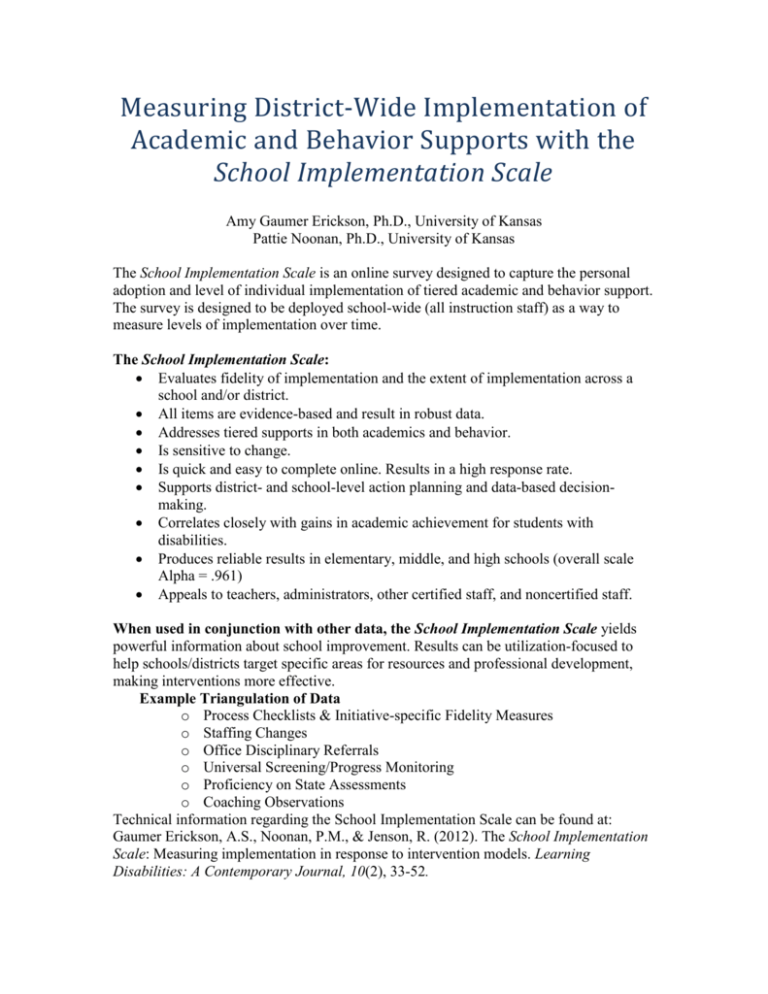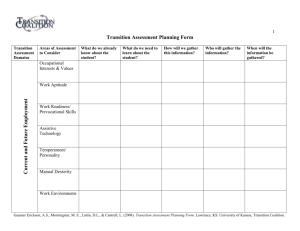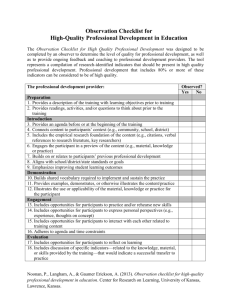School Implementation Scale: Measuring Academic & Behavior Supports
advertisement

Measuring District-Wide Implementation of Academic and Behavior Supports with the School Implementation Scale Amy Gaumer Erickson, Ph.D., University of Kansas Pattie Noonan, Ph.D., University of Kansas The School Implementation Scale is an online survey designed to capture the personal adoption and level of individual implementation of tiered academic and behavior support. The survey is designed to be deployed school-wide (all instruction staff) as a way to measure levels of implementation over time. The School Implementation Scale: Evaluates fidelity of implementation and the extent of implementation across a school and/or district. All items are evidence-based and result in robust data. Addresses tiered supports in both academics and behavior. Is sensitive to change. Is quick and easy to complete online. Results in a high response rate. Supports district- and school-level action planning and data-based decisionmaking. Correlates closely with gains in academic achievement for students with disabilities. Produces reliable results in elementary, middle, and high schools (overall scale Alpha = .961) Appeals to teachers, administrators, other certified staff, and noncertified staff. When used in conjunction with other data, the School Implementation Scale yields powerful information about school improvement. Results can be utilization-focused to help schools/districts target specific areas for resources and professional development, making interventions more effective. Example Triangulation of Data o Process Checklists & Initiative-specific Fidelity Measures o Staffing Changes o Office Disciplinary Referrals o Universal Screening/Progress Monitoring o Proficiency on State Assessments o Coaching Observations Technical information regarding the School Implementation Scale can be found at: Gaumer Erickson, A.S., Noonan, P.M., & Jenson, R. (2012). The School Implementation Scale: Measuring implementation in response to intervention models. Learning Disabilities: A Contemporary Journal, 10(2), 33-52. Administering the School Implementation Scale To administer the survey, please email all your instructional staff asking them to complete this short online survey. Survey responses will be automatically graphed, with the report available on www.orspdgdata.org. All responses are confidential and will be aggregated in reporting. Below is sample text for the email to be sent to all instructional staff in your district. Please contact Dr. Amy Gaumer Erickson (aerickson@ku.edu) with questions regarding this survey. _____(District Name) Staff, As part of the EBISS process, it is important to get your input on the current status of implementation at our school. The School Implementation Scale will provide valuable data that will be used to improve education for all students in our district. Please go to http://www.orspdgdata.net/Isrs/add1 and complete this short survey. Submit your survey by _____(one week from today). The data will then be analyzed and shared with you on _____(at the next inservice or via email). Thank you in advance for completing the survey. Sincerely, Interpreting the School Implementation Scale Results The School Implementation Scale Summary Reports provide aggregated data for your district and each school regarding the essential elements multi-tiered support systems. It is not expected that schools or districts will have high levels of implementation across all items. Instead, the results should be used to identify strengths and prioritize areas of improvement. Guided Discussion Questions for District/School Leadership Teams 1. Quickly glance through the data. What are your first impressions? 2. Does the number/role of survey participants adequately represent our schools? 3. Celebrate successes: Which items or essential elements show high levels of implementation? What processes, professional development, etc. are in place that support these high levels of implementation? 4. How do the results from the School Implementation Scale align with other schoollevel data? Is additional data needed? 5. Prioritize needs: Which essential elements show low levels of implementation? Which survey items highlight areas that could be improved over the next year? 6. Next steps: How do the results influence our action planning for next year?







![Action Plan Training for College of Education [Erickson Hall]](http://s3.studylib.net/store/data/006838784_1-e08201da1f024d72d03dde66b95777a5-300x300.png)



